Dogs
40 Spitz Dog Breeds That Look To Be So Cool! Petsdairy.com
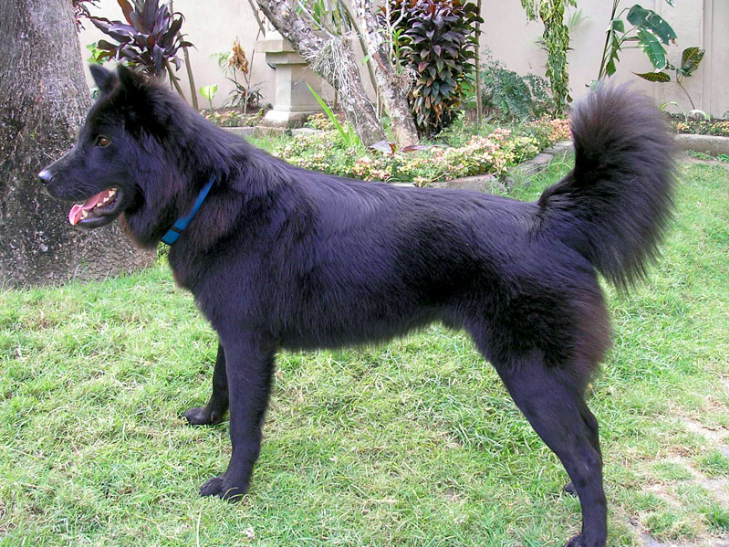
40 Spitz Dog Breeds That Look To Be So Cool
If you’re in the market for a new dog, Spitz breeds are a great place to start. Known for their fluffy coats and friendly personalities, these dogs are sure to steal your heart. In this ultimate guide, we’ll go over 40 different Spitz dog breeds, including their history, characteristics, and temperament.
What are Spitz Dogs?
Spitz dogs are a group of dog breeds that are characterized by their fluffy coats, pointed ears, and curled tails. They are a very diverse group, ranging from small companion dogs to large working breeds.
Most Spitz breeds originated in the Arctic regions of Europe and Asia and were bred for a variety of purposes, including hunting, herding, and sled pulling.
History of Spitz Dogs
Spitz dogs are one of the oldest dog groups in the world, with evidence of their existence dating back thousands of years. They were originally bred by indigenous people in the Arctic regions to help with hunting and transportation.
As humans began to explore and colonize other parts of the world, Spitz dogs were brought along, leading to the development of new breeds and the spread of existing ones.
Spitz dogs have a long and rich history that dates back thousands of years. They are believed to have originated in northern regions such as Siberia, Alaska, and Canada, where they were used for activities such as hunting, herding, and sled pulling.
Origins
The exact origins of Spitz dogs are unclear, but they are believed to have descended from ancient dog breeds that inhabited northern regions. These dogs were well-suited to the harsh climates, with thick fur coats and strong, athletic bodies that allowed them to survive and thrive in even the coldest and harshest of environments.
Early Uses
Spitz dogs were used for a variety of activities, depending on the specific breed and region. In Siberia, for example, Spitz dogs were used for herding reindeer, hunting games, and pulling sleds. In Alaska, they were used for hunting and pulling sleds, while in Canada, they were used for herding and hunting.
Popularity
Spitz dogs gained popularity outside of their native regions in the 19th and 20th centuries when they were introduced to other parts of the world through trade and exploration. They quickly became popular as working dogs and companions and were bred for specific traits such as size, coat color, and temperament.
Modern Day
Today, Spitz dogs are popular as family pets all over the world. Many breeds have been developed for specific purposes, such as the Alaskan Malamute and Siberian Husky for sled pulling, and the Shiba Inu and Chow Chow as loyal companions.
However, all Spitz breeds share certain physical and behavioral characteristics, such as thick fur coats, pointed ears, curled tails, and a strong prey drive. Overall, the history of Spitz dogs is a testament to their adaptability and resilience.
Despite evolving over thousands of years to suit specific environments and purposes, they have remained beloved companions and working dogs to this day.
Characteristics of Spitz Dogs
Spitz dogs are characterized by their thick fur coats, pointed ears, and curled tails. These features were originally developed to help them withstand harsh northern climates and protect them from the elements. Their thick fur coats are made up of two layers: a soft undercoat and a longer, coarser outer coat.
This helps to insulate them from the cold and keep them warm in even the harshest of conditions. However, it also means that they shed heavily and require regular grooming and brushing to maintain a healthy coat.
Spitz dogs are also known for their pointed ears, which stand erect and are usually triangular in shape. This helps them to hear and locate prey in their natural hunting environments.
Their ears are also highly expressive and can convey a range of emotions from curiosity to fear. Perhaps the most recognizable feature of Spitz dogs is their curled tail, which is usually carried over their back.
This tail helps to keep them warm by curling around their face and body when they sleep, and can also be used to communicate with other dogs. In terms of size, Spitz dogs can range from small to large.
Some, like the Pomeranian and Volpino Italiano, are small enough to be carried in a purse, while others, like the Alaskan Malamute and Siberian Husky, are large enough to pull sleds and other heavy loads.
Despite their differences in size and appearance, all Spitz breeds share certain traits, such as intelligence, independence, and a strong prey drive. These qualities make them well-suited for activities such as hunting, herding, and sledding, but also mean that they require a lot of exercise and mental stimulation to stay happy and healthy.
1). Keeshond Breed
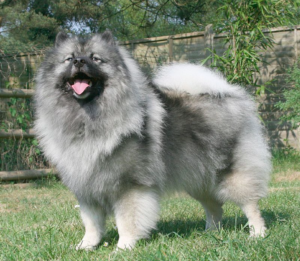
The Keeshond is a gentle, friendly, and people-loving dog distinguished by its very distinct “spectacle” face markings. They are originally from Holland, where they were used as security dogs and companions on the barges that floated across the rivers.
They are now extinct. Besides that, the Keeshond has a thick frill of fur that covers his shoulders and chest. Their thick coats are available in various colours, including grey, black, cream, and a mix of these.
Overview of the Breed
- Group: Non-Sporting (AKC)
- Height Length: 17 to 18 Inches.
- Weight Dimension: 35 to 45 Pounds
- Physical Characteristics and Colours: Known for its “spectacle” markings around the eyes, this breed has a thick double topcoat, woolly undercoat, and long outer coat, and it is available in cream, black, and grey colour varieties.
- Lifespan: 12 to 15 YEARS
2). The Siberian husky Breed
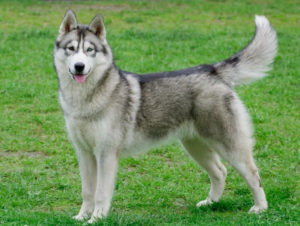
The Siberian husky is so great and one of the most well-known spitz dog breeds, and it is also among one of the most popular. When you watch this working dog sprinting through the cold tundra of its home, you wonder if you’ve seen a wolf or if you’ve just witnessed a working dog.
The Siberian husky was designed for both companionship and work, making them an excellent family dog for those who are ready and prepared to put in the time and effort to meet their high exercise requirements.
Overview of the Breed
- Group: Working (AKC)
- Height Length: 20 to 24 Inches.
- Weight Dimension: 35 to 60 Pounds
- Coat and colour: The eyes are usually blue or brown (or a combination of the two); the double-layered coat can be any colour, including black, grey, red, brown, tan, or white.
- Lifespan: 12 to 15 Years
3). Icelandic Sheepdog Breed
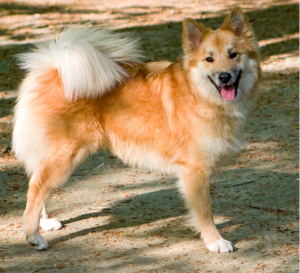
The Icelandic Sheepdog is the country’s only indigenous dog breed, making it a popular and well-liked pet. These joyful, energetic canines are on the smaller side of the spectrum, with the tallest reaching 18 inches.
Their forefathers and foremothers accompanied Norse settlers to Iceland. These dogs, which were bred for herding sheep and ponies, were the forefathers of the modern Iceland sheepdog that we know today.
Overview of the Breed
- Group: Herding (AKC)
- Height Length: 16 to 18 Inches
- Weight Dimension: 25-30 Pounds
- Coat and colour: A waterproof double thick coat that can be short or long and comes in a range of hues including fawn, cream, chocolate, black, and grey; all varieties have white markings and occasionally a black mask; all versions have white markings and sometimes a black mask.
- Lifespan: 12 to 14 years
4). Pomeranian Breed
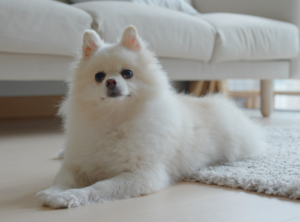
Not all spitz dog breeds are large and wolf-like in appearance. The Pomeranian is a little dog breed that weighs no more than 7 pounds and is classified as a toy dog breed.
Even though these tiny fluff balls do not have wolf-like proportions, they nonetheless have iconic pointed ears, long noses, and curled tails. Don’t be fooled by their diminutive size.
They may be little in stature, but they are imposing in personality. The breed is playful, confident, and intelligent, and they make excellent family dogs and watchdogs.
Overview of the Breed
- Group: Toys (AKC)
- Height Length: 6 to 7 Inches
- Weight Dimension: 3 to 7 Pounds
- Coat and colour: A thick coat with a profuse frill of fur covers the shoulders and chest; colours include white, black, blue, red, and cream; grey-shaded; tan; orange; brown; and other shades of brown.
- Lifespan: 12 to 16 years
5). Samoyed Breed
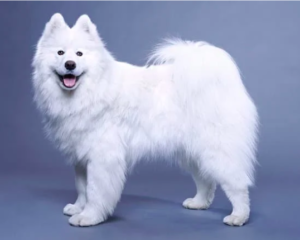
The Samoyed’s arctic origins are plainly visible in its dense, white fur and its sled-pulling, hunting, and herding history, which dates back thousands of years. These stunning white canines are pack-oriented and create strong ties with their owners.
They are also quite intelligent. They are considerate, hardworking, social, and dependable. These pups are well-known for their perpetual smile, and they have a cheerful demeanour to match.
Overview of the Breed
- Group: Working (AKC)
- Height Length: 19 to 24 Inches
- Weight Dimension: 35 to 50 Pounds (for Females); 45 to 65 Pounds (for Males).
- Coat and colour: A medium-sized dog with a robust physique and highly dense, white fur for warmth, the dog’s jaws are permanently tilted in a perpetual “smile.”
- Lifespan: 12 to 14 Years
6 Shiba Inu Breed
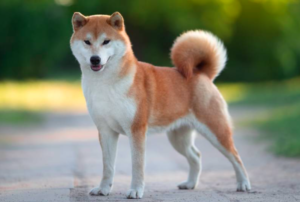
The Shiba Inu was originally or formerly bred as a hunting dog in Japan. This particular spitz breed is the most popular companion dog in Japan. They are devoted, courageous, and self-assured.
On the other hand, they are independent and strong-willed, and they can create extremely intimate ties with their families and friends. The Shiba Inu has a fox-like look, complete with a red fur coat. They are also available in two more colours: black and tan.
Overview of the Breed
- Group: Non-SPorting (AKC)
- Height Length: 13 to 17 Inches
- Weight Dimension: 17-23 Pounds
- Coat and Colour: A dense coat that can be red, black, and tan, or black and sesame with white patterns, is characteristic of this breed.
- Lifespan: 13 to 16 years.
7). Chow Chow Breed
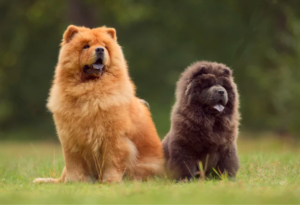
According to certain sources, this ancient Chinese dog breed has been bred for more than a millennium and may have originated as far back as 206 BCE. They were used as companions, guardians, hunters, and carriers, among other things.
These distinctive dogs are distinguished by their blue-black tongue, wrinkled face, and ruff on the back of their neck. Even though they are serious-mannered and reserved among strangers, chows can create exceptionally loyal ties with the people they care about.
Overview of the Breed
- Group: Non-Sporting (AKC)
- Height Length: 17 to 20 Inches
- Weight Dimension: 45-70 Pounds
- Coat and Colour: A prominent neck ruff in various hues, including black, blue, fawn, cream, and red; the blue-black tongue is well-known.
- Lifespan: 8 to 12 Years
8). American Eskimo Dog Breed (A.E.K.D.)
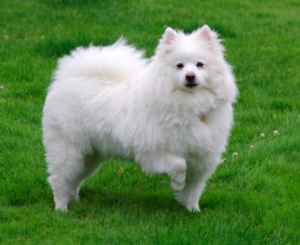
It is important to note that these gorgeous pure white canines have nothing to do with the indigenous Alaskan people known as “Eskimos.” The American Eskimo dog has German ancestors, and the German Spitz is considered to be its forefather.
These dogs made their way to America in the 1800s and immediately gained popularity because of their intelligence, attractive looks, and eagerness-to-please attitude. They make fantastic, affectionate companions for anyone looking for a companion on their next vacation.
Overview of the Breed
- Group: Non-Sporting (AKC)
- Height Length: 15 to 19 Inches for normal, 12 to 15 inches for miniature, and 9 to 12 Inches for a toy.
- Weight Dimension: Standard Model’s weight is 25 to 35 Pounds, Small Model’s weight is 10 to 20 Pounds, and Toy Model’s weight is 6 to 10 Pounds.
- Coat and Colour: Black nose, lips, and eye-rims, with a thick ruff over the neck and shoulder areas; the thick, white coat may also be seen in cream or “biscuit” colouration; the thick, white coat might also be seen in cream or “biscuit.”
- Lifespan: 13 to 15 Years
9). Alaskan Malamute Breed
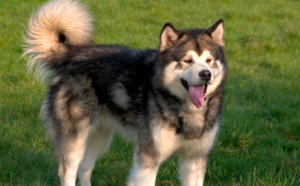
In its original homeland of Alaska, the Malamute is a powerful, active spitz dog bred for hauling and hunting. Despite their massive size, these dogs are giant softies who enjoy being a part of the family and participating in activities.
They make gentle, affectionate friends, but they are not often considered good watchdogs because of their amiable nature. Because of their active lifestyle in Alaska, they require a lot of physical activity.
Anyone considering adding a lovely Malamute to their family should be prepared to provide them with the exercise and affection they require to thrive.
Overview of the Breed
- Group: Working (AKC)
- Height Length: 23 to 25 Inches
- Weight Dimension: 75 to 85 Pounds
- Coat and Colour: A dense, double coat in various colours, including white, grey, black, brown, and red.
- Lifespan: 10 to 12 Years
10). Norwegian Buhund Breed
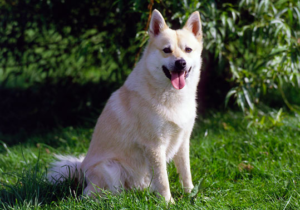
These dogs may be descendants of some of the earliest spitz dog breeds, travelling with the Vikings hundreds of years ago. It was common for them to be used on farms as herders, guards, and all-around farmhands.
The Buhund is still actively employed in Norway’s agricultural sector despite modern times. They are self-assured, intelligent, and affectionate, making this spitz dog breed an excellent working companion.
Overview of the Breed
- Group: Herding (AKC)
- Height Length: 16-to-19 Inches
- Weight Dimension: 26 to 40 Pounds
- Coat and Colour: The coat of this breed is thick, hard, and smooth-lying, with a soft and dense undercoat. The neck, chest, and backside of the thighs have longer coats, and the colours are wheaten (which ranges from pale cream to vivid orange) or black.
- Lifespan: 12 to 15 Years
11). Norwegian Elkhound Breed

The Norwegian Elkhound dog was a Viking companion dog who lived in the mountains of Norway. This breed of dog was highly prized and cherished, and some have even been discovered in the tombs of their masters, next to their swords and shield.
The elkhound appears in both Norse history and mythology as a hunting dog. Like the Norwegian Buhund, the elkhound was utilized on the farm for herding and guarding purposes, among other things.
In addition, as its name implies, the elkhound was employed in the pursuit of elk. These fearless, loyal, and kind-hearted canines are beautifully dedicated friends for those who want to be on the go and explore new places.
Overview of the Breed
- Group: Hound (AKC)
- Height Length: 19 to 21 Inches
- Weight Dimension: 48 to55 Pounds
- Coat and Colour: A luscious coat with silver-grey colouring thick and lengthy.
- Lifespan: 12 to 15 Years
12 Norwegian Lundehund Breed
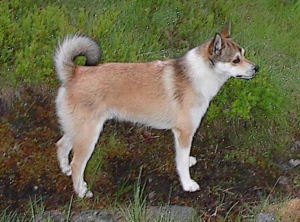
The Norwegian Lundehund is a spitz dog with unusual characteristics that is genuinely one-of-a-kind. These dogs, who were bred to hunt “Lunde” or puffins among rocky cliffs, have six functional toes on each paw, rather than the traditional dewclaws.
Their necks are extremely flexible, and they can bend back to the point that their heads come into contact with their spines. Using their pointed, upright ears, they may fold them forward or backwards and close them.
Furthermore, their front legs are extremely flexible, allowing them to extend entirely to their sides.
Overview of the Breed
- Group: Non-Sporting (AKC)
- Height Length: 12 to 15 Inches
- Weight Dimension: 20 to 30 Pounds
- Coats and Colour: Double coat with a harsh, short outer coat and a soft, dense undercoat; the males have a thicker ruff around the neck; coat colour can be black, white, sable, grey, or red; black hair tips that darken with age and can also have white, white with red, or dark markings.
- Lifespan: 12 to 14 Years
13). Finland Lapphund Breed
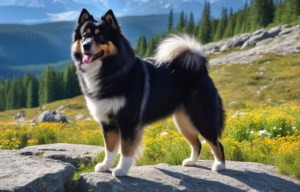
The Sami people utilized these extra-furry Arctic dogs for hunting and herding reindeer, and they were also used to herd sheep. It takes courage, intelligence, and fast thinking to perform this dangerous profession. In fact, the Finnish Lapphund is known for having a powerful “startle response,” which is a distinguishing characteristic of the breed.
This characteristic allows the Finnish Lapphund to respond swiftly and escape being attacked by enraged reindeer. Despite their reputation as swift, fearless hunters and herders, the Finnish Lapphund is an exceedingly loving and affectionate dog.
They are among the many Arctic dogs who have cuddled together with their owners to keep warm during cold weather, contributing to the development of a strong link between canines and humans through the years.
Overview of the Breed
- Group: Herding (AKC)
- Height Length: 16- 21 Inches
- Weight Dimension: 33 to 53 Pounds
- Physical Characteristics: a thick double coat that can be black, white, sable, brown or red.
- Lifespan: 12 to 15 Years
14). Swedish Vallhund Breed
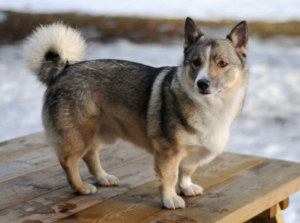
The Swedish Vallhund is another popular spitz dog that emerged as a result of the Vikings’ extensive conquests in Scandinavia. It is believed that the breed originated due to a mix between the Scandinavian spitz dog and the Welsh corgi breeds.
These dogs have a characteristic spitz appearance, with a squat, long profile and a short muzzle. These dogs make excellent cattle dogs because their tiny size allows them to avoid being kicked by kicking cattle’s hooves.
Overview of the Breed
- Group: Herding (AKC)
- Height Length: 11 to 14 Inches
- Weight Dimension: 20 to 35 Pounds
- Coats and Colour: The coat is medium in length and tough, with a close, tight topcoat and a soft, dense undercoat; a sable pattern in many shades of grey through red, and combinations of these colours; a sable pattern in various shades of grey through red, and combinations of these colours;
- Lifespan: 12 to 15 Years
15). Swedish Lapphund Breed
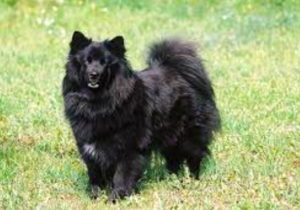
Known as one of the oldest canine breeds, the husky is a highly intelligent and active creature believed to have descended from the ancient Arctic wolf. They collaborated with the Sami people in order to hunt, guard, and herd their flocks.
They adore being an active member of the family and strive to participate in whatever they do. Despite their loyalty, these dogs are independent thinkers that can be obstinate at times. Their favourite cooperative activities are agility and scent work, and they perform admirably in these and other cooperative activities.
Overview of the Breed
- Group: Spitz and primitive types (FCI); not an AKC-recognized breed.
- Height Length: 16 to 20 Inches
- Weight Dimension: 30 to 45 Pounds
- Coats and Colour: The coat is long and thick, and it can be either black or brown, with little white spots on it.
- Lifespan: 12 to 14 Years
16). Finnish Spitz Breed
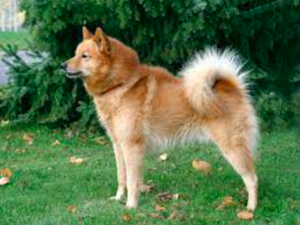
The Finnish Spitz, often known as the Finkie, is a foxy spitz breed distinguished by its pointed face and red colouration. These dogs were developed specifically for hunting, and they established a niche in the grouse-hunting industry.
These dogs are often called the “barking bird dog” because of their distinctive range of barks and yodels and their capacity to bark at speeds of up to 160 barks per minute. They have a specific hunting style that distinguishes them.
Once they have located their target, they fascinate it with slow tail waving and “yodelling,” which informs the huntsman that the animal has been captured. Even if they aren’t used for bird hunting, these happy, active dogs make excellent companions for their owners.
Overview of the Breed
- Group: Non-Sporting (AKC)
- Height Length: 15–20 Inches
- Weight Dimension: 20 to 33 Pounds
- Physical Characteristics: Double coat; golden-red coat with a variety of shades
- Lifespan: 13 to 15 Years
17). Kai Ken Breed
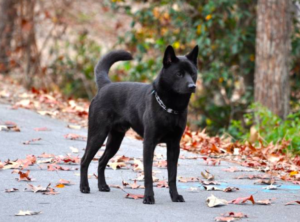
Developed in Japan for the purpose of hunting a diverse range of wildlife, the Kai ken is a powerful and agile dog. The Kai Ken is one of Japan’s six indigenous breeds, and it is highly recognized and adored by many people.
These creatures are fiercely loyal to their people, and they will go to considerable lengths to ensure that they are well-protected. They are exceptionally bright and learn new things at a breakneck pace.
These dogs are best known for their naturally camouflaged brindle coat, although they can also be found with black or red markings on their coats.
Overview of the Breed
- Group: AKC Foundation Stock Service; the AKC does not recognize this breed.
- Height Length: 15–20 Inches
- Weight Dimension: 20 to 40 Pounds
- Coat and Colour: Short but thick coat; born with a black coat that may develop a red later, black, or brown brindle pattern over the first five years of life; born with a black coat that may develop to a red, black, or brown brindle pattern over the first five years of life.
- Lifespan: 12 to 15 Years
18). Alaskan Klee Kai Breed
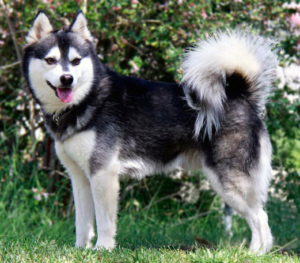
The Alaskan Klee Kai, despite appearing like a miniature husky, was developed for friendship rather than work. The Klee Kai is a very new dog breed that has only been around for over 50 years.
It was just recently recognized as a distinct breed by the United Kennel Club in 1997. The Alaskan Klee Kai is a spunky and energetic companion dog who would make a wonderful addition to any active family’s life. Even though they are protective of their families, they distrust outsiders, which makes them ideal watchdogs.
Overview of the Breed
- Group: Northern breed (UKC), the American Kennel Club does not recognize the breed.
- Height Length: 13 to 17 Inches
- Weight Dimension: 10 to 20 Pounds
- Coat and Colour: Thick but not excessively long, downy undercoat; classic “masked” colouration with a darker top and a darker mask and a white underside; the darker coat may be black, red, or grey; the lighter coat may be black, red, or grey.
- Lifespan: 12 to 16 Years
19). Karelian Bear Dog Breed
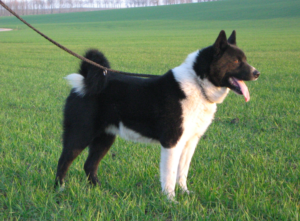
As implied by its name, the Karelian bear dog was bred by the Finnish to hunt large game such as bears. Independent and self-assured, these dogs work well independently and frequently only bark to alert their hunter when their prey has been cornered or halted.
When it comes to other dogs, the spitz dog breed’s strong fighting energy might make them possessive, but not when it comes to humans. They have also been utilized in search and rescue operations, sledding, and obedience trials, to name a few activities.
Overview of the Breed
- Group: Working (AKC Foundation Stock Service)
- Height Length: 19 to 24 Inches
- Weight Dimension: 44-50 Pounds
- Coat and Colour: Dense, short coat in black with white markings on the underside
- Lifespan: 11 to 13 Years
20). Yakutian Laika Breed
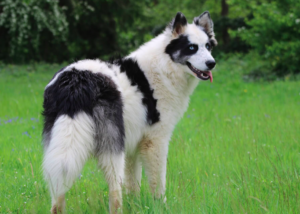
A variety of activities such as hunting, herding, sledding, and companionship were pioneered by the Yakut people in the Arctic northern region of the Russian Federation, leading to the development of the Yakutian Laika.
They are devoted, gentle dogs who enjoy being a part of the family’s daily activities and routines. They always get along well with children and other dogs as well. Their outgoing personalities make them excellent friends, but they are not good security dogs.
Overview of the Breed
- Group: Spitz and primitive kinds (FCI); not recognized by the American Kennel Club.
- Height Length: 21 to 23 Inches
- Weight Dimension: 40-55 Pounds
- Colour and coat: A thick, glossy, straight, medium-length double coat in any colour (black, white, brown, red or grey) can be used on any dog breed.
- Lifespan: 10 to 13 Years
21). Kintamani Breed
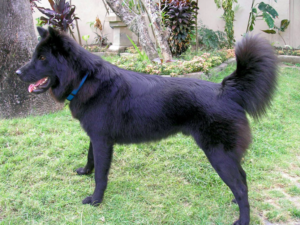
The Kintamani Bali dog is a wild canine found on the Indonesian island of Bali. Although it is feral, this Indonesian dog adapts well to family life and is frequently maintained as a pet.
In 2019, the International Canine Federation (FCI) recognized these canines as a distinct breed, establishing them as the first-ever. Given their wild roots, they are naturally possessive of their territory and do not interact well with other canines.
They make excellent watchdogs and are extremely affectionate toward the members of their families. Because these dogs are known to be good climbers, keep an eye on them at all times, even when they are in a fenced-in yard.
Overview of the Breed
- Group: Spitz and primitive kinds (FCI); not an AKC-recognized breed.
- Height Length: 17-23 Inches.
- Weight Dimension: 28 to 40 Pounds
- Colour and Coat: Double-coat, rough outer coat of medium length on the body and shorter on the face; it may be either white, black, fawn, red, or brindle in colour.
- Lifespan: 14 Years
22). Thai Bangkaew Dog Breed
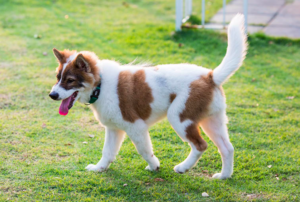
The Thai Bangkaew Dog is a well-known breed in Thailand’s Phitsanulok province, and it was named after a village in the region. According to some, the dog is thought to be a hybrid between an Asiatic jackal, a domestic Thai dog, and the shepherd dogs of the Song people.
The Thai Bangkaew was developed through selective breeding, which began in 1957. Because of their protective and alert nature, these dogs were kept as watchdogs and guardians for the benefit of the community.
They are wary of strangers, but they are devoted and loving members of the family once they are accepted. They can be aggressive towards other dogs, just like the Kintamani dog, so it is important to socialize and train them early on in life.
Overview of the Breed
- Group: Spitz and primitive kinds (FCI); not an AKC-recognized breed.
- Height Length: 17-to-21 Inches
- Weight Dimension: 35 to 60 Pounds
- Coat and colour: Males have a thick fur ruff at the neck that is generally thicker than females; coat colours can be black, white, grey, chocolate, tan, or red; coat colours can be black, white, grey, chocolate, tan, or red.
- Lifespan: 10 to 14 Years
23). Danish Spitz Breed
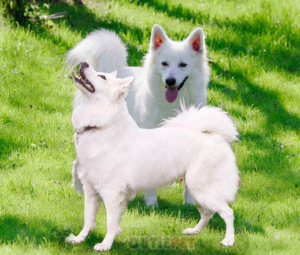
This loving, playful and patient family friend is affectionately referred to as “the children’s dog” by its owners. The following dogs: The Greenland Spitz, Samoyed Spitz, Wolf Spitz, and also the White Spitz, are just some of the many names given to these pups over the years.
They are well-liked farm dogs, and for many years, people relied on them to keep an eye on and entertain the children. The Danish spitz has a calm and friendly demeanour, making them delightful dogs to have around.
Overview of the Breed
- Group: This breed is not recognized by the American Kennel Club (AKC).
- Height Length: 15 to 19 Inches
- Weight Dimension: 26 to 40 Pounds
- Coat and Colour: A feathery coat that wraps over the neck and back of the legs, most usually white, although it can also be biscuit in hue.
- Lifespan: 15 Years
24). Eurasier Breed
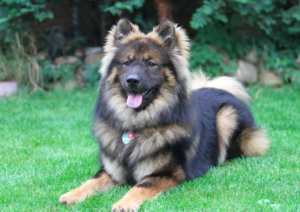
Eurasiers may appear to be a tough, obnoxious breed, but they are, in fact, sensitive souls with a loving and calm disposition. They must spend time with their loved ones to be content.
As implied by their name, the Eurasier is descended from both European and Asian ancestors. The Wolf Spitz, the Chow Chow, and the Samoyed are all descendants of the Wolf Spitz. There is a great range of colours available for their coat, and even their tongues can be a mixture of purple and pink.
Overview of the Breed
- Group: American Kennel Club Foundation Stock Service (AKC FSS)
- Height Length: 19 to 24 Inches
- Weight Dimension: 40-70 Pounds
- Coat and Colour: It is a double coat with hair shorter on its face, ears, and front area of the legs and longer on its tail, backs of the legs, and neck; any colour or a mix of colours except pure white and piebald.
- Lifespan: 14 Years
25). Schipperke Breed
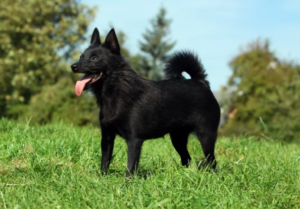
They were originally bred as watchdogs and were trained to hunt rats onboard ships, making them quite distinctive. Their powerful jaws and necks made them the ideal candidates for the job. Known as the “little skipper,” the schipperke is a self-assured and energetic guardian, giving them the nickname.
These canines are distinguished by their fox-like appearance, a thick ruff of fur around their necks, and outspoken personality. These dogs make excellent watchdogs and companions since they are lively and brave, and well-known for their fondness for water.
Overview of the Breed
- Group: Non-Sporting (AKC)
- Height Length: 10 to 13 Inches
- Weight dimension: 10 to 16 Pounds
- Coat and colour: A dense coat with a thick ruff around the neck and a dense coat that is typically black but can also be chocolate or cream in colour.
- Lifespan: 12 to 14 Years
26). Volpino Italiano Breed
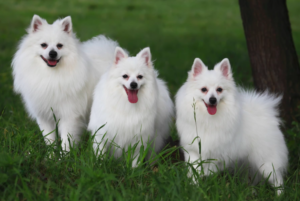
They are closely related to the Pomeranian and the German spitz, but they have distinct qualities and history that distinguish them from the other breeds. It is believed that these dogs have been present for hundreds of years and have been shown in artworks dating back to the 1500s. They are energetic, fun-loving friends who are also good watchdogs.
Overview of the Breed
- Group: Spitz and primitive kinds (FCI); AKC Foundation Stock Service; AKC Foundation Stock Service
- Height Length: 9 to 12 Inches
- Weight Dimension: 9 to 12 Pounds
- Coat and Colour: A thick coat that stands off from the body and generates a thick ruff around the neck; fawn, red, black, or champagne are common colours, although other colours such as fawn, red, black, or champagne are also acceptable.
- Lifespan: 14 to 16 Years
27). Japanese Spitz Breed
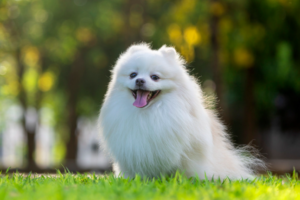
They are yet another tiny spitz breed, and these little white dogs are known for their happy-go-lucky, comedian-like personalities and their strong attachments to their owners. These dogs are very sharp and eager to learn, and they are willing to embark on any adventure, provided it is with the person they adore.
This spitz dog breed makes an excellent watchdog because they have a loud bark for such a small dog. It is not difficult for them to adjust to apartment living as long as they continue to get daily walks.
Overview of the Breed
- Group: AKC Foundation Stock Service
- Height Length: 12 to 15 Inches
- Weight Dimension: 10 to 25 Pounds
- Coat and Colour: Thick, upstanding coat with a ruff around the neck; the coat is a bright white colour.
- Lifespan: 12 to 14 years
28). Indian Spitz Breed
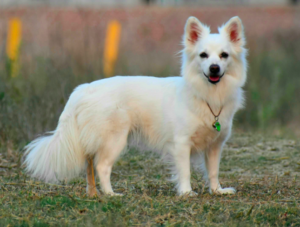
The Indian spitz, which is said to have descended from the German spitz, is renowned for its intelligence and friendliness, and it is a popular pet. Their friendly demeanour makes them excellent with children and other pets. The expressive faces of the Indian spitz are a distinguishing characteristic of the species.
Many people have green or blue eyes, which draws attention to this characteristic. Each of the two groups, the lesser Indian spitz and the greater Indian spitz, is distinguished by its size.
Overview of the Breed
- Group: This breed is not recognized by the American Kennel Club.
- Height Length: 8 to 10 Inches for the smaller; 14 to 18 Inches for the larger
- Weight Dimension: 11 to 15 Pounds for the smaller; 26 to 44 Pounds for the larger
- Coat and colour: Many have blue or green eyes and have thick, upstanding fur; coats can be white, black, or brown, and many have blue or green eyes.
- Lifespan: 10 to 16 Years
29). Western Siberian Laika Breed
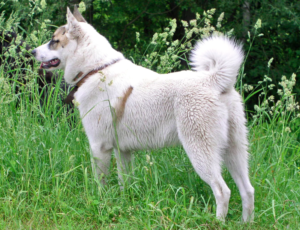
It is believed that these born hunters were among the canine breeds that hunted alongside humans during prehistoric times. With such a long and illustrious history, it is no surprise that these dogs have retained some of the appearance and characteristics of the wolf. A high prey drive and a protective, territorial mentality characterize their behaviour.
It is easy for them to be affectionate toward members of their adopted people, or “pack.” Those who receive proper training will find them to be loyal and protective companions.
Overview of the Breed
- Group: Spitz and Native types (FCI); Northern breed (UKC); not recognized by the American Kennel Club (AKC).
- Height Length: 20 to 24 Inches
- Weight Dimension: 40 to 55 Pounds
- Coat and Colour: A medium-length coat in various colours, including white, grey, black, and red.
- Lifespan: 12 to 14 Years
30). Shikoku Breed
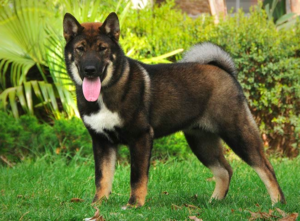
These dogs’ Shikoku got their origin from The Kochi prefecture on the island of Shikoku, where these Japanese dogs got their start, and it is also where their name comes from.
These dogs, which were bred to hunt wild boars in mountainous terrain, have a strong, agile build and a lot of energy. If they are given the activity and attention they require, these dogs can make excellent companions combined with intellect and loyalty.
Overview of the Breed
- Group: Spitz and primitive type (FCI) is not an AKC-recognized breed.
- Height Length: 17 to 22 Inches
- Weight Dimension: 35-55 Pounds
- Coat and Colour: A short to medium-length coat that can be black and tan, red, or sesame in colour.
- Lifespan: 13 to 15 Years
31). Akita Breed
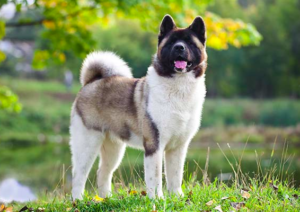
The Akita, the spitz family’s characteristic wolf or fox-like visage, is replaced by a more bear-like expression. The courage and loyalty of these larger, heftier Japanese canines are well-known among their owners.
They are extremely well-liked and respected in Japan. Hachiko, a well-known Akita, sat at a train station for nine years, waiting for his owner to arrive back home. His previous owner had passed very unexpectedly many years before.
This breed of dog is fiercely loyal and protective of the people they care about. They make wonderful companions for those who have the time and resources to train and care for them properly.
Overview of the Breed
- Group: Working (AKC)
- Height Length: 24 to 28 Inches
- Weight Dimension: Females weigh 70 to 100 Pounds; males weigh 100 to 130 Pounds
- The Colour and Coat: Akitas have a short, dense double-layered coat that can be white, black, brindle, sesame, or red; others have a recessive trait that causes them to have a long coat.
- Lifespan: 10 to 13 Years
32). Russo-European Laika Breed
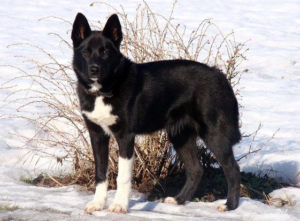
The Russian-European Laika is linked or closely related to the Karelian bear dog’s appearance and behaviour. Even though these tough hunting dogs can take down big games such as bears, their typical prey consists of squirrels and other small game.
As suggested by its name, this breed originated in the northern parts of Russia and Europe and has since spread worldwide. This smaller Laika breed is bursting with enthusiasm, intelligence, and courage, and it is extremely devoted to its family, which includes youngsters.
Because of its assertive demeanour and protective character, it is territorial towards other dogs and must be properly trained as a result.
Overview of the Breed
- Group: Spitz and Native types (FCI); Northern breed (UKC); not recognized by the American Kennel Club (AKC).
- Height Length: 19 to 23 Inches
- Weight Dimension: 40 to 50 Pounds
- Coat and Colour: A dense coat that is black or grey with white patterns is worn by this dog.
- Lifespan: 10 to 12 Years
33). Pungsan Dog Breed
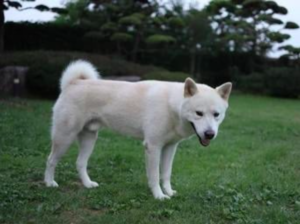
Although the actual origins of the Pungsan dog are unknown, it is believed that they were raised for hunting purposes in North Korea. These canines enjoy being outdoors and are renowned for their bravery.
The Pungsan dog was bred to hunt tigers and wild boars. These canines are highly esteemed in their native North Korea, and in 2000, the president of North Korea presented two Pungsan dogs to the president of South Korea as a token of his appreciation.
Pungsan is again the name of a town in the South Korean province of Gyeonggi. They are wonderful family dogs and watchdogs who are both protective and loving.
Overview of the Breed
- Group: The breed is not recognized by the American Kennel Club.
- Height Length: 21 to 24 Inches
- Weight Dimension: 45 to 65 Pounds
- Colour and Coat: A short to medium-length dense coat in a white or cream-white tint is worn by people with short to medium hair.
- Lifespan: 12 to 15 Years
34). Norrbottenspets Breed
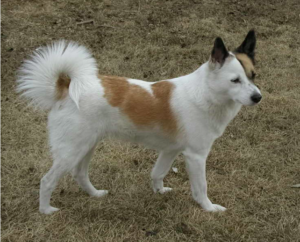
Despite its small size, the Norrbottenspets is one of the most resilient creatures on the planet. Dogs like these were utilized for hunting in the icy Scandinavian peninsula, where they were agile and tough.
Despite the fact that this breed had been assumed to be extinct for a time, they have continued to exist as guard dogs and companions in the area of North Bothnia.
They are still considered to be an uncommon dog breed today. Despite being brave hunters, they are also kind and affectionate friends at home.
Overview of the Breed
- Group: AKC Foundation Stock Service
- Height Length: 16-18 Inches
- Weight Dimension: 20 to 30 Pounds
- Coat and Colour: The coat is a short, dense white with red, brown, or tan patches.
- Lifespan: 14 to 17 Years
35). Kishu Ken Breed
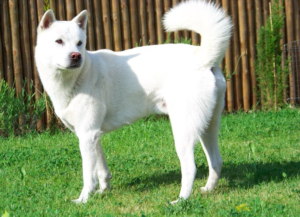
The Kishu Ken is a fiercely devoted and noble warrior class. These dogs were bred in Japan to be fearless hunters, and while they can be boisterous when out hunting, they can also be calm and loving when at home.
They are emotionally attached to their family and friends, but they are distant from strangers. As a result of their high prey drive, they may not be the best choice for households with other small animals. These noble dogs are regarded as a national treasure in Japan, and they are only rarely exported outside of the country.
Overview of the Breed
- Group: AKC Foundation Stock Service
- Height Length: 17 to 22 Inches
- Weight Dimension: 30 to 60 Pounds
- Coat and Colour: The coat of this dog is short and dense, and it can be white, brindle, red, black, or sesame in colour.
- Lifespan: 11 to 13 Years
36). Korean Jindo Breed
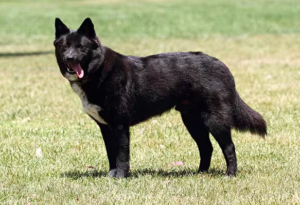
Once these fiercely loyal Korean dogs have chosen their person, they will remain loyal to that person for the rest of their lives. These dogs, which originated on the Korean island of Jindo, have been utilized for hunting for thousands of years.
In Korea, they are regarded as a national treasure. Two Jindo dogs were given to the president of North Korea by the president of South Korea in exchange for two Pungsan dogs given to the president of South Korea.
Jindo, agile and clever, requires a great deal of mental and physical stimulation.
Overview of the Breed
- Group: Spitz and primitive types (FCI)
- Height Length: 18 to 22 Inches
- Weight Dimension: 30 to 50 Pounds
- Dog Colour and Coat: The dog has a strong and solid build with an alert and dignified appearance; the thick coat comes in various colours, including white, black, brindle, black and tan, wolf grey, and red fawn.
- Lifespan: 12 to 14 Years
37). Hokkaido Dog Breed
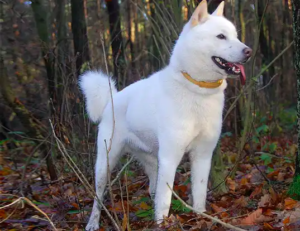
Historically, it is believed that these tough Japanese dogs travelled to the island of Hokkaido with the Ainu people, where they adapted to the harsh climate. They are loyal companions and fearless hunters, and they are employed in the hunting of large game such as deer and bear.
Their sharp minds and high energy levels enable them to succeed at problem-solving. Therefore, they are extremely protective of their loved ones and suspicious of strangers, making early socialization critical.
Overview of the Breed
- Group: AKC Foundation Stock Service; AKC Foundation Stock Service (FCI)
- Height Length: 18 to 20 Inches
- Weight Dimension: 44 to 66 Pounds
- Colour and coat: A dense coat in various colours, including red, black, black and tan, sesame, brindle, and white.
- Lifespan: 12 to 15 Years
38). Greenland Dog Breed
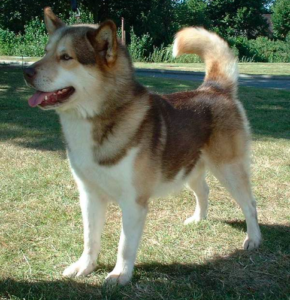
When the Eskimos went hunting or dragging sleds, the Greenland dog was there to assist them. They are admired for their endurance, strength, and work ethic, among other qualities.
They have outspoken personalities and do not become unduly connected to a single individual. They require clear limits and training, but once they have been established in an adopted family or “pack,” they can be extremely affectionate.
Even though they are self-sufficient, they are sociable toward others and do not make ideal watchdogs.
Overview of the Breed
- Group: Spitz and Native types (FCI); Northern breed (UKC); not recognized by the American Kennel Club (AKC).
- Height Length: 21 to 25 Inches
- Weight Dimension: 60 to 75 Pounds
- Coat and colour: A medium-length coat in any of the following colours: black, white, grey, or brown.
- Lifespan: 10 to 12 Years
39). Caanan Dog Breed
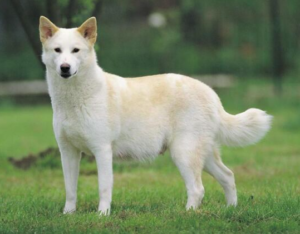
These dogs, known as the national dog of Israel, have been herding and protecting livestock in the area or place that used to be known as Caanan for thousands of years.
These dogs have lived in the wild in the Israeli deserts for a long time before being domesticated once more in the twentieth century. During World War II, they were even trained to be service dogs.
Despite the fact that they are self-assured, agile, and tireless, the Canaan dog makes an excellent companion or friend to those who can provide them with the appropriate training and exercise.
Overview of the Breed
- Group: Herding (AKC)
- Height Length: 19 to 24 Inches
- Weight Dimension: 35 to 55 Pounds
- Coat and Colour: A short, dense double coat that is composed of a harsh, flat outer coat and a softer undercoat; colour can be white, black, brown, red, tan, or a combination of these colours.
- Lifespan: 12 to 15 Years
40). German Spitz Breed
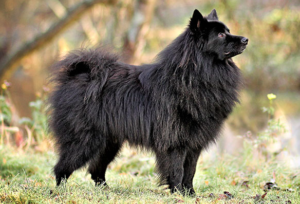
Even though they are frequently confused with Pomeranians, the German Spitz is their larger cousin. This spitz dog breed, which is closely related to the Pomeranian and the Keeshond, shares much of the same history and characteristics as these German breeds, especially the well-known neck ruff.
Their attentiveness and willingness to be outspoken make them great watchdogs. They are energetic, loyal to their family, and apprehensive of strangers.
Overview of the Breed
- Group: AKC Foundation Stock Service; AKC Foundation Stock Service (FCI)
- Height Length: 12 to 15 Inches
- Weight Dimension: Between 24 and 26 Pounds
- Coat and colour: A compact breed with distinguishing spitz traits and iconic ruff around the neck area; thick, upstanding coat can be white, black, black and tan, cream, brown, orange, or grey
- Lifespan: 13 to 15 Years
Breeds to Stay Away From
Any dog designated as a spitz breed possesses eye-catching wolf-like features. Even though they make beautiful companions, weigh other considerations before taking steps if you intend to add a furry friend to the family.
Many spitz breeds’ physical and mental activity, such as huskies and malamutes, may make them unsuitable for less physically active people.
While beautiful, other dogs, such as the Finnish Spitz, are known for barking a lot and might not be a good option if you live in a neighbourhood where your neighbours are close by.
Moreover, Spitz breeds have a double coat and again shed their coats twice a year, which might increase allergies for persons sensitive to dogs.
With hundreds of different breeds of dogs to choose from in the canine world, you may pick the appropriate breed to suit your lifestyle and family with careful consideration and research.
Questions People Also ask: (FAQs)
What is a Spitz dog?
A Spitz dog is a type of dog breed that originated in northern regions, characterized by a thick fur coat, pointed ears, and a curled tail.
Are Spitz dogs good family pets?
Yes, many Spitz breeds make great family pets due to their loyal and affectionate nature. However, it’s important to research the specific breed’s temperament and exercise needs to ensure they will be a good fit for your lifestyle.
What are some common Spitz breeds?
Some common Spitz breeds include the Siberian Husky, Shiba Inu, Alaskan Malamute, and Chow Chow.
Are Spitz dogs good with children?
Yes, many Spitz breeds are good with children due to their friendly and playful nature. However, it’s important to supervise interactions between dogs and children to ensure everyone stays safe.
How much exercise do Spitz dogs need?
Spitz dogs are generally very active and require a lot of exercise and mental stimulation to stay happy and healthy. This can include activities such as long walks, hikes, and playtime in a fenced yard.
Are Spitz dogs easy to train?
Spitz dogs are generally intelligent and trainable, but can also be independent and stubborn at times. Proper training and socialization are key to raising a well-behaved and obedient Spitz dog.
Do Spitz dogs shed a lot?
Yes, many Spitz breeds have thick fur coats that shed heavily, especially during seasonal changes. Regular grooming and brushing can help to manage shedding and keep your dog’s coat healthy and shiny.
We appreciate you for taking the time to read this article!
Finally, we hope you found this article interesting? And what do you think about ”40 Spitz Dog Breeds That Look To Be So Cool!?”
Please feel free to share or inform your friends about this article and this site, thanks!
And let us know if you observe something that isn’t quite right.
Dogs
The Touching Story Behind Why a Dog Lays on a Particular Spot in the Yard

The Touching Story Behind Why a Dog Lays on a Particular Spot in the Yard: A Tale of Unbreakable Loyalty
Dogs are known for their incredible loyalty, but sometimes their devotion to those they love can manifest in heart-wrenching ways. This is the case with one dog whose habit of laying on a specific spot in the yard has left many people in tears. What may appear to be a simple, everyday action carries with it a deeper, heartbreaking reason that has moved dog lovers and pet owners alike.
In this article, we will delve into the emotional backstory of why this dog chooses that special spot and what it reveals about the profound bond between pets and their owners.
The Unbreakable Bond Between Humans and Dogs
Dogs have long been known as “man’s best friend.” Their unwavering loyalty and companionship can turn them into integral parts of our families. They sense our emotions, offer comfort in times of need, and provide joy and laughter. The bond between humans and dogs is unique, and for many, their pet becomes more than just an animal — they are family.
Why Do Dogs Form Such Strong Attachments?
One of the reasons dogs are so loyal is due to their pack mentality. In the wild, dogs live and hunt in packs, forming tight-knit social groups. When domesticated, they transfer this pack behavior to their human families. Dogs will go to great lengths to remain close to those they consider part of their pack, and when a member is lost, the dog often mourns deeply.
@talltaz The whole yard and he only lays on top of where we buried her 🥺😭 #petloss #grief #fyp
The Story of the Loyal Dog and the Special Spot in the Yard
In one particular case, a dog’s loyalty is demonstrated in an incredibly poignant way. After the passing of the dog’s owner, the pet began to exhibit unusual behavior — lying down on the same spot in the yard every single day. At first, the family thought it was just a comfortable place for the dog to rest, but they soon realized that the spot held a special significance.
The Meaning Behind the Spot
The spot where the dog lays is the same place where the owner used to spend time with the dog, sitting outside together, enjoying the fresh air and the sunshine. After the owner passed away, the dog returned to that spot daily, as if waiting for the person to return. The dog’s actions have been described as a form of mourning, a way of staying close to their beloved human even after they’ve gone.
How Pets Grieve the Loss of Their Owners
Just like humans, dogs can experience grief when they lose someone they love. The signs of grief in dogs can include changes in behavior, loss of appetite, and separation anxiety. In some cases, dogs may return to places that remind them of their owner, like the loyal dog who lays on that specific spot in the yard.
Signs of Grieving in Dogs
- Loss of Appetite: One of the most common signs of a grieving dog is a refusal to eat or a noticeable decrease in appetite.
- Withdrawal: A grieving dog may become less active or less interested in playing, choosing instead to lay in one place for long periods.
- Whining or Howling: Some dogs will vocalize their sadness through whines or howls, particularly when they are in a place that reminds them of their owner.
- Searching: It’s not uncommon for dogs to search the house or yard for their lost companion, wandering around or sniffing in places where their owner used to be.
The Science Behind Dogs and Grief
Research into canine behavior has shown that dogs are capable of feeling complex emotions, including grief. A study by the American Society for the Prevention of Cruelty to Animals (ASPCA) revealed that more than 60% of dogs exhibited signs of grief after the loss of a companion pet, and it’s reasonable to believe that they would react similarly after losing a human companion. The dog’s brain processes emotions in much the same way as the human brain, and they often form deep emotional bonds that are difficult to break.
How Dogs Cope With Loss
Dogs, much like humans, cope with loss in different ways. While some may exhibit signs of sadness or distress, others might become more clingy or protective of their remaining family members. Providing them with comfort, attention, and familiar routines can help them cope with their feelings of loss.
Helping a Grieving Dog
If your dog is showing signs of grief, it’s essential to provide them with support and understanding. They may need extra care and attention during this difficult time. Here are a few ways to help a grieving dog:
- Stick to a Routine: Keeping a regular routine can provide a sense of stability and security for your pet.
- Give Them Extra Attention: Spending more time with your dog, offering affection and comfort, can help ease their sadness.
- Offer Comforting Items: Items that smell like the deceased owner, such as clothing or bedding, may help the dog feel close to their lost companion.
A Dog’s Loyalty Knows No Bounds
The story of the dog lying on that specific spot in the yard is just one of many examples of how deeply dogs feel their connections to humans. It highlights the incredible loyalty that dogs have for their owners, even after death. Dogs don’t just offer companionship while we are alive; they continue to show their love and dedication long after we’re gone.
Other Heartwarming Stories of Canine Loyalty
This isn’t the only story of a dog displaying remarkable loyalty. There are countless stories of dogs who wait for their owners, return to places they once shared, or exhibit behaviors that suggest they are mourning the loss of their loved ones. One of the most famous examples is the story of Hachiko, the Japanese Akita who waited at a train station every day for nearly ten years after his owner’s death. Such stories remind us of the deep emotional lives of our pets and the bonds they form with us.
Conclusion
The heartbreaking story of the dog laying on a specific spot in the yard is a testament to the unbreakable bond between humans and their pets. It’s a reminder that dogs are not just pets; they are loyal, loving companions who feel loss and grief just as deeply as we do. For this particular dog, that spot in the yard is more than just a place to rest; it’s a symbol of the inseparable bond they shared with their owner.
Frequently Asked Questions (FAQs)
Why does my dog lay in a specific spot every day?
Dogs often return to places that have sentimental value, either due to memories they associate with the spot or because it reminds them of their owners. In some cases, a dog may lay in a particular spot because it feels safe or comforting.
Can dogs really feel grief after losing an owner?
Yes, dogs are capable of feeling grief. They can show signs of sadness, withdrawal, loss of appetite, and even changes in behavior when they lose a companion, whether it’s another pet or a human.
How can I help my grieving dog cope with the loss of a family member?
You can help your grieving dog by providing extra attention, maintaining a consistent routine, and offering comforting items like their owner’s clothing or bedding. It’s important to give them time to adjust and to provide emotional support.
How long does it take for a dog to overcome grief?
The grieving process can vary from dog to dog. While some dogs may recover within a few weeks, others may take months to adjust. It’s essential to be patient and offer them the love and care they need during this time.
Are there any other signs that a dog is grieving?
Aside from loss of appetite and withdrawal, a grieving dog may become more vocal, clingy, or exhibit behaviors like searching the house for their lost companion. Each dog grieves differently, so it’s crucial to observe their behavior and provide comfort when needed.
We appreciate you for taking the time to read this article!
Finally, we hope you found this article interesting? And what do you think about ”The Touching Story Behind Why a Dog Lays on a Particular Spot in the Yard!?”
Please feel free to share or inform your friends about this article and this site, thanks!
And let us know if you observe something that isn’t quite right.
References: Heartbreaking Reason Dog Lays on Specific Spot in Yard
Dogs
How Do Dogs Know Their Rescuers and Adopters?

How Do Dogs Know Their Rescuers and Adopters?
Dogs are often considered man’s best friend, and for good reason. Their loyalty, empathy, and innate ability to form deep connections with humans are truly remarkable. But one question that has intrigued pet lovers and researchers alike is: How do dogs recognize their rescuers and adopters?
This seemingly simple question opens up a world of complex emotional and cognitive processes that dogs undergo when they meet someone who will become an important part of their lives.
In this comprehensive exploration, we will delve into the science and emotion behind a dog’s ability to recognize and bond with their rescuers and adopters. From the impact of scent and body language to the neurological responses in a dog’s brain, we will uncover the many layers that contribute to this profound connection.
The Bond Between Humans and Dogs
A Relationship Rooted in History
The relationship between humans and dogs dates back thousands of years. Originally, dogs were domesticated from wolves, and through selective breeding, they evolved into the varied breeds we know today. This long history has led to a deep bond between the two species, with dogs becoming attuned to human emotions, behaviors, and cues.
Understanding the Human-Dog Connection
Dogs have evolved to become incredibly perceptive to human emotions. This connection is so strong that dogs can often sense when their owners are happy, sad, or anxious. This ability is due in part to the oxytocin hormone, often referred to as the “love hormone.” Both dogs and humans release oxytocin when they interact positively, strengthening their bond.
How Dogs Recognize Their Rescuers
The Role of Scent in Recognition
Dogs have an extraordinary sense of smell—up to 100,000 times more sensitive than that of humans. This acute olfactory ability allows them to pick up on a wide range of scents, including those associated with specific people. When a dog is rescued, the first thing they often do is sniff their rescuer. This initial interaction helps the dog form a scent-based memory of the person who saved them.
The Importance of Body Language
In addition to scent, dogs rely heavily on body language to interpret human intentions. A rescuer’s calm demeanor, gentle movements, and soft voice can reassure a frightened dog and help them form a positive association. Dogs are incredibly intuitive and can quickly pick up on the non-verbal cues that indicate whether a person is a friend or foe.
Voice Recognition and Emotional Tone
Dogs are also highly attuned to the tone of voice used by their rescuers. A soothing, calm voice can help alleviate a dog’s anxiety and build trust. Over time, dogs can learn to recognize their rescuer’s voice and associate it with safety and comfort.
Adoption: The Beginning of a New Bond
The First Meeting
The initial meeting between a dog and their adopter is a critical moment. During this time, the dog will use all of their senses—smell, sight, hearing, and touch—to assess the person. A successful first meeting often involves allowing the dog to approach the adopter on their own terms, giving them the space to feel safe and secure.
Building Trust Over Time
Trust is not built overnight. It takes time, patience, and consistency for a dog to fully trust their adopter. This process can be particularly challenging for dogs that have experienced trauma or neglect. However, with love and understanding, even the most fearful dogs can learn to trust again.
The Role of Routine in Bonding
Dogs thrive on routine. Establishing a consistent routine with regular feeding times, walks, and play sessions helps a dog feel secure in their new environment. This sense of security is crucial for building a strong bond between a dog and their adopter.
The Science Behind the Bond
Neurological Responses in Dogs
When a dog interacts with their rescuer or adopter, their brain undergoes several changes. Research has shown that positive interactions with humans can increase levels of oxytocin in a dog’s brain. This hormone is responsible for feelings of love and attachment, similar to the bond between a parent and child.
The Role of the Amygdala
The amygdala, a part of the brain involved in processing emotions, plays a crucial role in how dogs perceive their rescuers and adopters. This area of the brain helps dogs recognize familiar faces and respond to emotional cues, further strengthening the bond between dog and human.
Dopamine and Positive Reinforcement
Dopamine, another important neurotransmitter, is released in a dog’s brain during positive interactions with their owner. This “feel-good” chemical reinforces the bond by making the dog associate their owner with feelings of happiness and pleasure.
Emotional Intelligence in Dogs
Dogs’ Ability to Empathize
One of the most remarkable aspects of dogs is their ability to empathize with humans. Studies have shown that dogs can sense when their owner is upset and will often try to comfort them. This emotional intelligence is a key factor in the deep bond that forms between a dog and their rescuer or adopter.
Recognizing Human Emotions
Dogs can recognize and respond to human emotions through facial expressions, tone of voice, and body language. This ability to understand and react to human emotions is a result of thousands of years of co-evolution, making dogs incredibly in tune with their owners.
Challenges in Forming Bonds with Rescued Dogs
Overcoming Trauma
Many rescued dogs come from backgrounds of abuse, neglect, or abandonment. These traumatic experiences can make it difficult for them to trust humans. Patience, understanding, and professional training are often required to help these dogs overcome their past and form new bonds with their adopters.
The Role of Positive Reinforcement
Positive reinforcement is a powerful tool in helping rescued dogs build trust with their adopters. Rewarding good behavior with treats, praise, and affection can help a dog associate their adopter with positive experiences, making it easier for them to bond.
The Importance of Socialization
Socialization is key to helping rescued dogs feel comfortable in their new environment. Introducing them to new people, places, and other animals in a controlled and positive manner can help reduce anxiety and build confidence.
The Power of Love and Patience
Stories of Successful Bonds
Countless stories exist of dogs who, despite their difficult pasts, have gone on to form deep and lasting bonds with their adopters. These stories are a testament to the power of love, patience, and understanding in helping dogs heal and trust again.
The Impact of a Forever Home
For many rescued dogs, finding a forever home is a life-changing experience. The security, love, and care they receive from their adopters can help them overcome their past and live a happy, fulfilling life.
How Do Dogs Know They’ve Found Their Forever Family?
The Subtle Signs of Recognition
Dogs have a unique way of showing that they recognize and trust their adopters. Some of these signs include following their owner around the house, seeking out physical affection, and displaying relaxed body language. These subtle behaviors are a clear indication that a dog has formed a strong bond with their adopter.
The Role of Consistency and Care
Consistency in care is crucial in helping a dog feel secure in their new home. Regular feeding times, walks, and play sessions help establish a routine that dogs can rely on, making them feel safe and loved.
Understanding Your Dog’s Language
Dogs communicate their feelings in various ways, including through their body language, vocalizations, and behavior. Understanding these signals is key to building a strong, trusting relationship with your dog.
Conclusion: The Deep Connection Between Dogs and Their Rescuers
The bond between a dog and their rescuer or adopter is one of the most profound relationships in the animal kingdom. It is built on trust, love, and understanding, and is reinforced by the many ways dogs communicate and connect with their human companions.
Whether through scent, body language, or the release of oxytocin and dopamine, dogs have a unique ability to recognize and bond with the people who save them. This connection is not only a testament to the emotional intelligence of dogs but also to the deep-rooted history and co-evolution of the human-dog relationship.
Frequentions Asked Questions (FAQs)
Can dogs remember their rescuers even after many years?
Yes, dogs have excellent long-term memories, especially when it comes to people who have made a significant impact on their lives, such as rescuers. A dog’s strong sense of smell and emotional memory allow them to remember their rescuers even after a long time.
How can adopters help a dog adjust to their new home?
Adopters can help their dog adjust by establishing a consistent routine, providing plenty of positive reinforcement, and allowing the dog to explore their new environment at their own pace. Patience and understanding are key to helping a dog feel secure in their new home.
Do dogs feel gratitude towards their rescuers?
While dogs may not feel gratitude in the same way humans do, they do form strong emotional bonds with their rescuers. These bonds are often based on trust, safety, and the positive experiences shared with their rescuer.
How do dogs recognize their rescuers or adopters?
Dogs have an incredible sense of smell and memory, which helps them recognize their rescuers or adopters. They can remember the unique scent of a person, even if they haven’t seen them for a long time. Additionally, dogs are highly perceptive to body language and voice tone, which allows them to form a bond and recognize their humans through these cues.
How long does it take for a dog to bond with a new adopter?
The time it takes for a dog to bond with a new adopter can vary depending on the dog’s personality, past experiences, and the environment. Some dogs may form a bond within days, while others may take weeks or even months to fully trust and connect with their new owner. Patience, consistency, and positive reinforcement are key to building a strong bond.
Can a dog remember its rescuer after being adopted by someone else?
Yes, dogs can remember their rescuers even after being adopted by someone else. Their powerful memory, especially when it comes to emotional experiences, allows them to retain the scent, voice, and actions of those who have helped them. If a dog meets its rescuer again, it may show signs of recognition and affection.
What role does scent play in a dog recognizing its rescuer or adopter?
Scent plays a crucial role in how dogs recognize people. A dog’s sense of smell is thousands of times more sensitive than that of humans, allowing them to pick up on subtle scent cues that we can’t detect. When a dog is rescued or adopted, it memorizes the unique scent of its new human, which helps it identify and remember them later.
How can adopters help a rescue dog feel secure and loved?
To help a rescue dog feel secure and loved, adopters should provide a stable environment, consistent routines, and plenty of positive reinforcement. Spending quality time with the dog, offering treats, and giving gentle attention can help the dog feel safe. It’s also important to be patient and understanding, as rescue dogs may need time to adjust to their new surroundings and form a bond with their adopter.
We appreciate you for taking the time to read this article!
Finally, we hope you found this article interesting? And what do you think about ”How Do Dogs Know Their Rescuers and Adopters?!?”
Please feel free to share or inform your friends about this article and this site, thanks!
And let us know if you observe something that isn’t quite right.
Dogs
Exploring the Diverse World of Dog Breeds: A Look at the Seven Main Groups + the others

Exploring the Diverse World of Dog Breeds: A Look at the Seven Main Groups + the others
Dogs are one of the most diverse species on the planet, with hundreds of different breeds that vary widely in size, shape, temperament, and behavior. To help organize this diversity, dog breeds are often grouped into categories based on their original purpose or characteristics.
These groups, recognized by kennel clubs and breed organizations worldwide, provide a framework for understanding the different types of dogs and their typical traits. Here are the main groups of dogs:
- Sporting Group: These dogs were bred for hunting game birds, both on land and in the water. They are known for their stamina, intelligence, and willingness to please. Breeds in this group include the Labrador Retriever, Golden Retriever, and English Springer Spaniel.
- Hound Group: Hounds are known for their keen sense of smell and ability to track prey. They are often used for hunting and tracking game. Breeds in this group include the Beagle, Bloodhound, and Greyhound.
- Working Group: Dogs in this group were bred for specific tasks, such as guarding property, pulling sleds, or performing water rescues. They are known for their strength, intelligence, and trainability. Breeds in this group include the Siberian Husky, Boxer, and Great Dane.
- Terrier Group: Terriers were originally bred to hunt and kill vermin. They are known for their feisty and energetic nature. Breeds in this group include the Jack Russell Terrier, Bull Terrier, and Scottish Terrier.
- Toy Group: Toy breeds are small companion dogs that were bred for their portable size and charming personalities. They are often kept as lap dogs or companions. Breeds in this group include the Chihuahua, Pomeranian, and Shih Tzu.
- Non-Sporting Group: This group is a diverse collection of breeds that don’t fit into other categories. They vary widely in size, coat type, and temperament. Breeds in this group include the Bulldog, Poodle, and Dalmatian.
- Herding Group: These dogs were bred to control the movement of other animals, such as sheep or cattle. They are known for their intelligence, agility, and strong herding instincts. Breeds in this group include the Border Collie, Australian Shepherd, and German Shepherd Dog.
Each group has its own unique characteristics and traits, but all dogs share a common bond with humans as loyal companions and working partners. Understanding these groups can help you choose a breed that fits your lifestyle and preferences.
Sporting Group
- American Water Spaniel
- Boykin Spaniel
- Chesapeake Bay Retriever
- Clumber Spaniel
- Curly-Coated Retriever
- English Setter
- Flat-Coated Retriever
- Gordon Setter
- Irish Red and White Setter
- Irish Setter
- Irish Water Spaniel
- Nova Scotia Duck Tolling Retriever
- Pointer
- Spinone Italiano
- Sussex Spaniel
- Vizsla
- Weimaraner
- Welsh Springer Spaniel
- Wirehaired Pointing Griffon
Hound Group
- Afghan Hound
- American English Coonhound
- American Foxhound
- Basenji
- Black and Tan Coonhound
- Borzoi
- Cirneco dell’Etna
- Finnish Spitz
- Grand Basset Griffon Vendéen
- Greyhound
- Harrier
- Ibizan Hound
- Norwegian Elkhound
- Otterhound
- Petit Basset Griffon Vendéen
- Pharaoh Hound
- Plott
- Portuguese Podengo
- Redbone Coonhound
- Rhodesian Ridgeback
- Saluki
- Scottish Deerhound
- Sloughi
- Treeing Walker Coonhound
- Whippet
Working Group
- Akita
- Alaskan Malamute
- Anatolian Shepherd Dog
- Bernese Mountain Dog
- Black Russian Terrier
- Boerboel
- Boxer
- Bullmastiff
- Cane Corso
- Dogo Argentino
- Dogue de Bordeaux
- Greater Swiss Mountain Dog
- Great Pyrenees
- Komondor
- Kuvasz
- Leonberger
- Mastiff
- Neapolitan Mastiff
- Newfoundland
- Rottweiler
- Samoyed
- Siberian Husky
- St. Bernard
- Tibetan Mastiff
Terrier Group
- Airedale Terrier
- American Staffordshire Terrier
- Australian Terrier
- Bedlington Terrier
- Border Terrier
- Bull Terrier
- Cairn Terrier
- Cesky Terrier
- Dandie Dinmont Terrier
- Glen of Imaal Terrier
- Irish Terrier
- Kerry Blue Terrier
- Lakeland Terrier
- Manchester Terrier
- Miniature Bull Terrier
- Miniature Schnauzer
- Norfolk Terrier
- Norwich Terrier
- Parson Russell Terrier
- Russell Terrier
- Scottish Terrier
- Sealyham Terrier
- Skye Terrier
- Smooth Fox Terrier
- Soft Coated Wheaten Terrier
- Staffordshire Bull Terrier
- Welsh Terrier
- West Highland White Terrier
- Wire Fox Terrier
Toy Group
- Affenpinscher
- Brussels Griffon
- Cavalier King Charles Spaniel
- Chihuahua
- Chinese Crested
- English Toy Spaniel
- Havanese
- Italian Greyhound
- Japanese Chin
- Maltese
- Manchester Terrier (Toy)
- Miniature Pinscher
- Papillon
- Pekingese
- Pomeranian
- Poodle (Toy)
- Pug
- Shih Tzu
- Silky Terrier
- Toy Fox Terrier
- Yorkshire Terrier
Non-Sporting Group
- American Eskimo Dog
- Bichon Frise
- Boston Terrier
- Bulldog
- Chinese Shar-Pei
- Chow Chow
- Dalmatian
- Finnish Spitz
- French Bulldog
- Keeshond
- Lhasa Apso
- Lowchen
- Norwegian Lundehund
- Poodle (Miniature)
- Schipperke
- Shiba Inu
- Tibetan Spaniel
- Tibetan Terrier
- Xoloitzcuintli
Herding Group
- Australian Cattle Dog
- Australian Shepherd
- Bearded Collie
- Belgian Malinois
- Belgian Sheepdog
- Belgian Tervuren
- Border Collie
- Bouvier des Flandres
- Briard
- Canaan Dog
- Cardigan Welsh Corgi
- Collie (Rough)
- Collie (Smooth)
- German Shepherd Dog
- Icelandic Sheepdog
- Miniature American Shepherd
- Norwegian Buhund
- Old English Sheepdog
- Pembroke Welsh Corgi
- Polish Lowland Sheepdog
- Puli
- Pyrenean Shepherd
- Shetland Sheepdog
- Spanish Water Dog
- Swedish Vallhund
Miscellaneous Class
- American Hairless Terrier
- Barbet
- Biewer Terrier
- Boerboel
- Coton de Tulear
- Czechoslovakian Vlcak
- Lagotto Romagnolo
- Mudi
- Nederlandse Kooikerhondje
- Peruvian Inca Orchid
- Portuguese Podengo
- Rat Terrier
- Russian Toy
- Sloughi
- Thai Ridgeback
- Xoloitzcuintli
Rare Breeds
- Azawakh
- Bergamasco
- Chinook
- Cirneco dell’Etna
- Dandie Dinmont Terrier
- Finnish Lapphund
- Finnish Spitz
- Grand Basset Griffon Vendéen
- Kooikerhondje
- Lagotto Romagnolo
- Lowchen
- Norwegian Lundehund
- Otterhound
- Peruvian Inca Orchid
- Schipperke
- Sealyham Terrier
- Skye Terrier
- Sussex Spaniel
- Swedish Vallhund
- Tibetan Mastiff
Designer and Hybrid Breeds
- Labradoodle (Labrador Retriever + Poodle)
- Goldendoodle (Golden Retriever + Poodle)
- Cockapoo (Cocker Spaniel + Poodle)
- Pomsky (Pomeranian + Husky)
- Maltipoo (Maltese + Poodle)
- Cavapoo (Cavalier King Charles Spaniel + Poodle)
- Yorkipoo (Yorkshire Terrier + Poodle)
- Sheepadoodle (Old English Sheepdog + Poodle)
- Bernedoodle (Bernese Mountain Dog + Poodle)
- Aussiedoodle (Australian Shepherd + Poodle)
- Shih-Poo (Shih Tzu + Poodle)
- Boxerdoodle (Boxer + Poodle)
- Schnoodle (Schnauzer + Poodle)
- Chorkie (Chihuahua + Yorkshire Terrier)
- Puggle (Pug + Beagle)
- Cockapoo (Cocker Spaniel + Poodle)
- Labradoodle (Labrador Retriever + Poodle)
- Goldendoodle (Golden Retriever + Poodle)
- Cockapoo (Cocker Spaniel + Poodle)
- Pomsky (Pomeranian + Husky)
- Maltipoo (Maltese + Poodle)
- Cavapoo (Cavalier King Charles Spaniel + Poodle)
- Yorkipoo (Yorkshire Terrier + Poodle)
- Sheepadoodle (Old English Sheepdog + Poodle)
- Bernedoodle (Bernese Mountain Dog + Poodle)
- Aussiedoodle (Australian Shepherd + Poodle)
- Shih-Poo (Shih Tzu + Poodle)
- Boxerdoodle (Boxer + Poodle)
- Schnoodle (Schnauzer + Poodle)
- Chorkie (Chihuahua + Yorkshire Terrier)
- Puggle (Pug + Beagle)
Rare and Uncommon Breeds
- Bergamasco Shepherd
- Catahoula Leopard Dog
- Chinook
- Finnish Spitz
- Glen of Imaal Terrier
- Kooikerhondje
- Lagotto Romagnolo
- Mudi
- Otterhound
- Peruvian Inca Orchid
- Portuguese Podengo
- Pyrenean Shepherd
- Russian Toy
- Saluki
- Sloughi
- Swedish Vallhund
- Tibetan Mastiff
- Toy Fox Terrier
- Xoloitzcuintli
Conclusion
In conclusion, the world of dogs is incredibly diverse, with hundreds of breeds that vary widely in size, shape, temperament, and behavior. To help categorize this diversity, dog breeds are grouped into categories based on their original purpose or characteristics.
These groups, such as the Sporting Group, Hound Group, Working Group, Terrier Group, Toy Group, Non-Sporting Group, and Herding Group, provide a framework for understanding the different types of dogs and their typical traits.
Each group has its own unique characteristics and traits, but all dogs share a common bond with humans as loyal companions and working partners. Whether you’re looking for a hunting companion, a family pet, a working dog, or a lap dog, there’s a breed out there for everyone.
Understanding these groups can help you choose a breed that fits your lifestyle and preferences, ensuring a happy and fulfilling relationship between you and your canine companion.
Frequently Asked Questions (FAQs)
What are some breeds in the Sporting Group, and what are their typical characteristics?
Some breeds in the Sporting Group include the Labrador Retriever, Golden Retriever, and English Springer Spaniel. These breeds are known for their high energy levels, intelligence, and friendly nature. They are often used for hunting and retrieving game.
Which breeds are typically found in the Hound Group, and what sets them apart from other groups?
The Hound Group includes breeds such as the Beagle, Bloodhound, and Greyhound. Hounds are known for their keen sense of smell and ability to track prey. They are often used for hunting and tracking game.
What are some examples of breeds in the Working Group, and what are their common characteristics?
Breeds in the Working Group include the Siberian Husky, Boxer, and Great Dane. These dogs were bred for specific tasks, such as guarding property or pulling sleds. They are known for their strength, intelligence, and trainability.
Can you name a few breeds from the Terrier Group, and what makes them unique?
Terriers, such as the Jack Russell Terrier, Bull Terrier, and Scottish Terrier, were originally bred to hunt and kill vermin. They are known for their feisty nature and high energy levels.
What are some breeds in the Toy Group, and what role do they typically play in households?
The Toy Group includes breeds like the Chihuahua, Pomeranian, and Shih Tzu. These breeds are small in size and are often kept as lap dogs or companions. They are known for their portable size and charming personalities.
We appreciate you for taking the time to read this article!
Finally, we hope you found this article interesting? And what do you think about ”Exploring the Diverse World of Dog Breeds: A Look at the Seven Main Groups!?”
Please feel free to share or inform your friends about this article and this site, thanks!
And let us know if you observe something that isn’t quite right.
-

 Pet Care2 years ago
Pet Care2 years agoThe Best Dog Collars For 2022
-

 Dogs2 years ago
Dogs2 years agoBichon Frise: The Happy, Playful, and Cuddly Companion
-

 Trending Pet Stories1 year ago
Trending Pet Stories1 year ago2023 ‘World’s Ugliest Dog’ Winner: Scooter’s Tale of Resilience
-

 Animals3 years ago
Animals3 years agoAre There Animals Having Down Syndrome?
-

 Pets2 years ago
Pets2 years agoThe Fascinating World Of The Red Chameleon
-

 Dogs3 years ago
Dogs3 years agoTop 10 Most Popular Dog Breeds According To AKC.
-

 Dogs3 years ago
Dogs3 years ago21 Dog Breeds That Resemble Bears Or Teddy Bears!
-

 Dogs3 years ago
Dogs3 years agoEskimo Dogs from Canada – What Are They? – Find Out!







